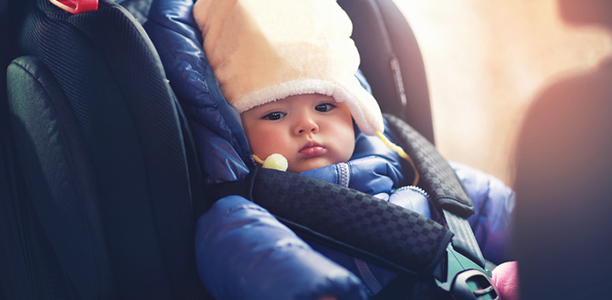The right car seat to choose depends on your child’s age and size. It is important to buy the right type of child restraint, as Australian laws not only state that children up to seven years of age must travel in a car seat, they also specify the type of seat they must use.
However, once you’ve identified the type of car seat you legally require, there will be plenty of choices you still need to make about the design of the car seat.
Car seat requirements
All car seats used in Australia must comply with Australian manufacturing standards and be labelled to show that they do. They must be sold with instructions detailing their correct installation and use.
The right type of car seat depends on your child’s age. Until about six months of age, babies should travel in a rear facing restraint (baby capsule). Thereafter, a forward facing car seat with a built-in five- or six-point harness should be used until about four years of age. Older children must travel in a booster seat until they are seven years of age, and it is recommended that they continue to do so until they are 145cm tall.
Some modern cars have built in booster seats (called integrated booster seats). These are only suitable for children four years and older.
Car seat extras
Many characteristics of the car seat you choose won’t be governed by laws. But things like correct fit and ease of use are also important to consider when buying a car seat. You are more likely to use a car seat correctly if it is easy to use.
Correct fit
A key point to consider when choosing a child restraint is how well it fits in your car (and if you are about to change cars, whether or not it will fit in the new car). Child restraints come in different shapes and sizes, so you’ll undoubtedly be able to find one that’s just right for your child and your car. But shop around and do a test installation in your car before making a purchase.
Ease of use
You will probably use your car seat a lot, so it’s important to ensure it is easy to use. To begin with, make sure you install it in a position that is safe but easy to access, so you can correctly put your child in and fasten the belt. The car seat should also be easy to install. The Child Restraint Evaluation Program (CREP) provides a blue star rating system for new car seats, indicating ease of use. Those that score the most blue stars are the easiest to use.
Safety rating
Car seats must be tested to see how safe they are in a crash. All car seats sold and used in Australia must comply with Australian standards and are reasonably safe. However, CREP conducts further tests, including a measurement of how far a child’s head and torso move during impact. Based on these tests, car seats are given a safety rating. The safety of a car seat is indicated by a purple star rating. The more purple stars, the safer the restraint.
Also look out for safety features. For example, booster seats with sash guides to ensure the correct positioning of the belt, or features that prevent a child from slipping under the lap belt in a crash.
When to buy a car seat
If you are waiting for the arrival of a new baby and planning to travel by car with your baby (including home from hospital), buy and fit a rear facing car seat before you give birth. If you plan on taking your baby home by car, it is a legal requirement for you to have an approved restraint, fitted for your baby to travel in.
As your child grows, you will need to buy a new child restraint before they outgrow their old one. For a baby using a rear facing restraint, this is usually at about six months of age, although it does depend on how quickly your baby grows. They should remain in the rear facing restraint until their shoulders reach the maximum height marker (for newer restraints) or the slot for the top shoulder strap (older restraints).
Thereafter, they should move on to a forward facing restraint with harness and use it until they are about four years of age, then a booster seat until at least 7 years of age. Again, it depends on your child’s height and weight. Refer to the height markers printed on newer model car seats, or use the top shoulder strap slot as a marker that your child has outgrown their restraint.
Do not buy a new car seat just because your child has turned four or seven years of age. If they still fit comfortably in their old car seat, it is safest to keep travelling with them in that seat. If they outgrow their car seat before their milestone birthday, it is safer to upgrade them to the next type of seat a bit early, rather than have them sitting in a seat that is too small.

Accommodating growth
Children can grow very quickly, so buying a car restraint that can accommodate their growth can reduce the need to buy multiple restraints.
If you are buying a car seat for a new baby, consider a combination rear facing device which can be converted to a forward facing device when your child is big enough (usually about six months of age). When choosing a booster seat, try to find one which can accommodate their growth until they reach a height of 145cm.
Disposing of a used car restraint safely
If your child’s restraint gets damaged in an accident or becomes worn out, it is important to dispose of it safely, so that no one will pick it up and start using it. You should cut the harness off and remove the padding from the shell of the restraint.
Tips for choosing a child car seat
- Never buy or accept as a gift a child restraint that you don’t know the history of. It may have been in a crash and be unsafe.
- Never use a car seat that has been in an accident. Car seats should be discarded immediately after an accident.
- Be wary of purchasing a child restraint online. It may not meet the Australian Safety Standards.
- Only buy a car seat that meets the Australian Standards and has a label to prove it.
- Only use a car seat that comes with the manufacturer’s instructions. Follow them carefully when installing the seat in the car.
- Never purchase a secondhand car seat that has signs of wear and tear. For example, one that is sun damaged or stretched, or has frayed or torn straps.
References
- Queensland Government. Child restraints [online]. 2015 (cited 30 July 2015). Available from: URL Link
- Product Safety Australia. Child car restraints for use in motor vehicles [online]. 2017 (cited 25 May 2017). Available from: URL Link
- New South Wales Government. Child car seats [online]. 2015 (cited 30 July 2015). Available from: URL Link
- Vic Roads. Children aged between 4-7 years [online]. 2015 (cited 26 May 2017) Available from: URL Link
- NSW Transport. Buying a child car seat [online]. 2015 (cited 13 August 2015). Available from: URL Link
- Neuroscience Research Australian and Kidsafe. Best practice guideline for the safe restraint of children travelling in motor vehicles [online]. 2013 (cited 13 August 2015). Available from: URL Link
- NSW Transport. Ratings explained [online]. 2015 (cited 13 August 2015). Available from: URL Link
- NSW Transport. Safe disposal of a child car seat [online]. 2015 (cited 13 August 2015). Available from: URL Link
- Kidsafe WA. Child car restraints [online].2017 (cited 26 May 2017). Available from: URL Link
- Vic Roads. Frequently asked questions about child restraints [online]. 2015 (cited 26 May 2017). Available from: URL Link
- Tasmanian Government. Child restraints: A guide to car seats [online]. 2015 (cited 30 July 2015). Available from: URL Link



 (4 votes, average: 4.50 out of 5)
(4 votes, average: 4.50 out of 5) 






